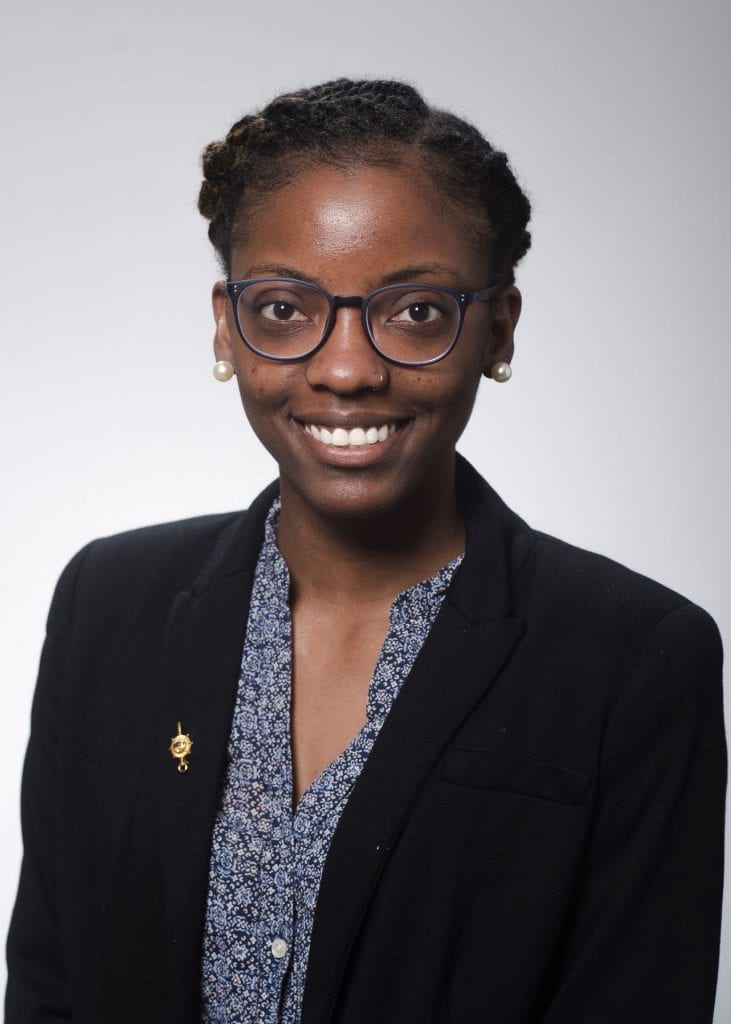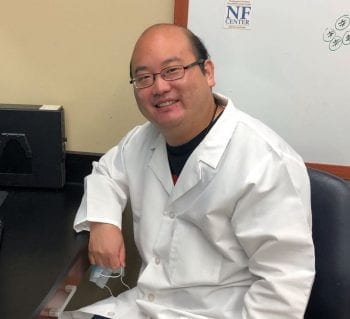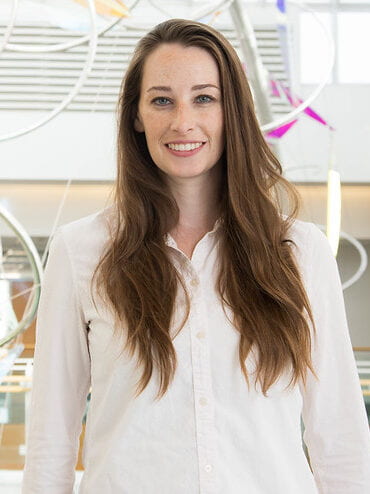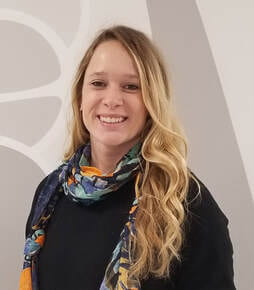Sade Williams Clayton, PhD

Postdoctoral Fellow, Simon Tang’s lab
PhD, University of Alabama
Briefly describe your project: My scientific focus is how the intervertebral disc stimulates repair and regeneration after injury and to discover which immune cell types play a role in disc repair.
Who is your scientific hero? Katherine Johnson, a mathematician whose calculations were critical for the first US crewed space flightsWhat is your favorite scientific method or paper (if you have one)?
What is your favorite scientific method or technique? My favorite method or technique is anything involving microscopy. Pictures can convey complex ideas in easily digestible ways by serving as visual aids for the audience.
When did you know you wanted to be a scientist? My junior year of undergrad when I took a developmental biology course. I was fascinated by the dynamic yet organized way that development of an organism progressed and knew from that moment I wanted to become a developmental biologist.
If you weren’t a scientist, what would you be? I would have become a therapist because I love interacting with and helping people.
What’s your favorite place in St. Louis? I love the Coma Coffee shop in Brentwood. The coffee is great and its my favorite place to unwind.
What are some exciting areas of regenerative medicine? I am really intrigued by the usage of biologics, or stem cell based therapies, to treat pain and aiding in repair after injuries. I think the field has great potential though there is still much progress to made in perfecting the efficacy of these treatments.
Alexander Chen, PhD

Postdoctoral Fellow, David Gutmann’s Lab
PhD, Emory University
Briefly describe your project: The goal of my project is to determine whether progenitors capable of forming low-grade glioma-like lesions share a common molecular signature that defines the cell of origin for these tumors, and whether different cells of origin in the setting of specific pilocytic astrocytoma driver mutations dictate the unique spatial and temporal patterning of these pediatric LGGs.
Who is your scientific hero? Galileo Galilei, for he is the father of modern science and the scientific method.
What is your favorite scientific method? I don’t have one. I believe that methods are more a means to an end.
When did you know you wanted to be a scientist? I knew I wanted to be a scientist around middle school. I spent some time shadowing my mother in a basic research lab and loved every minute of it.
What would you be if you weren’t a scientist? A pianist.
What is your favorite place in St. Louis? Forest Park
What are some exciting areas of regenerative medicine? I am excited by the use of human induced pluripotent stems cells as powerful models to study low-grade gliomas and in turn, develop more effective treatment options for LGG patients.
Rowan Karvas, PhD

Postdoctoral Fellow, Thorold Theunissen’s Lab
PhD, University of Missouri, Colombia
Briefly describe your project: My project involves building an in vitro model system of the human implantation process that integrates maternal and embryonic cell types. The goal is to study interactions between the maternal environment and trophoblast cells obtained from human pluripotent stem cells as a basis for understanding the mechanisms of implantation failure and placental diseases.
Who is your scientific hero? I have always admired Rita Levi Montalcini. She had so much bravery and strength to continue her work in her bedroom when Mussolini banned Jewish people from becoming scientists! Not to mention she was a she! My modern scientific hero is Dr. Theresa Woodruff who pioneered the field of onco-fertility. Preserving fertility is rarely a part of the conversation in cancer biology because oncologists are focused on saving the patient’s life and not their reproductive capabilities, but with optimism and innovation, both can be possible! Meeting her a few years ago was an inspiring experience for me and I hope to carry her unwavering encouragement of women scientists further to my own students.
What is your favorite scientific method or publication? The Human Placenta written in 1970 by Hamilton and Boyd. It has a number of great reference images for early implantation-stage development and it’s fascinating to read how far we’ve come since this time! The library should change its location to my desk!
When did you know you wanted to be a scientist? I realized I was completely hooked into science during my undergraduate training with Dr. Danny Stark in Dr. D Cornelison’s lab at Mizzou. I was assisting Danny with implanting mouse satellite cells into quail embryos and I found the quail embryos so beautiful! It amazed me how similar the embryos were, having the exact number of somites and symmetry, I had to keep studying development!
What would you be if you weren’t a scientist? A musician. Pursuing science was my plan B! I’m still able to play music for fun and I love that I get to use my brain in lots of ways, both creatively/emotionally and logically.
What is your favorite place in St. Louis? The bluffs at Castlewood State Park, especially at this time of year when the leaves are starting to change colors. The bluffs overlook the forest and the Meramec river. It’s so beautiful!
What are some exciting areas of regenerative medicine? I’m most excited for the combination of organoid culture with bioengineering techniques that will help to create more in vivo like models in the dish! This will allow for more consistent, intermediate states of stem cells to be isolated and studied. What’s most exciting about this to me is that we don’t know what sorts of states we will find until we study them! The potential for finding these important intermediate states may be key for regenerative therapies in adults.
Past Trainees
Dana Shaw, PhD

Postdoctoral Fellow, Mayssa Mokalled’s Lab
PhD, University of Utah
Briefly describe your project: Unlike mammals, zebrafish can spontaneously regenerate their spinal cord after injury. My project aims to identify the cellular mechanisms that support this regeneration.
Who is your scientific hero? George Streisinger. He is widely considered the father of using zebrafish as a model organism. By beginning work on a new model system, he was taking a huge risk. It is so unfortunate that he was not able to see how zebrafish research has given life to entire fields of study.
What is your favorite scientific method or publication? My favorite experiment I think must be the groundbreaking work by Hilde Mangold on the Spemann organizer. Here, she duplicated an entire embryonic axis of a Xenopus embryo by manipulating only a small handful of cells. This was one of the first images I saw in my undergraduate developmental biology courses and I have never forgotten it.
When did you know you wanted to be a scientist? I knew from a very young age that I needed to have a job where I could constantly ask questions. I drove my parents crazy with taking apart my toys to see how they worked.
What would you be if you weren’t a scientist? One of the few things I love as much as science are my dogs. It would definitely be something to do with working with dogs. I think I would enjoy being a veterinarian or running a rescue for stray dogs.
What is your favorite place in St. Louis? Definitely the Enterprise Center for a St. Louis Blues game. I have been a St. Louis Blues fan for my entire life. I even named my dog after their mascot.
What are some exciting areas of regenerative medicine? I think with the advent of single-cell sequencing, we can define cell-types and transition states of which we did not have a clear understanding. Combining these transcriptomes with targeted mutagenesis and functional screens has (and will continue to) allowed us to generate cell types in vitro that will provide therapeutic options that would not have been possible years ago.
Distinguished Affiliated Trainees
Postdoctoral Fellow, Stratman Lab
PhD, Kansas State University
Briefly describe your project: I am working on understanding the molecular mechanisms involved in arterial blood vessel stabilization. My main project is to determine links between blood flow sensing and recruitment of vascular smooth muscle cells to the dorsal aorta during vascular development in the zebrafish.
Who is your scientific hero? I don’t want to diminish the work of other scientist, but if I have to pick one it would be Rosalind Franklin, and her critical contributions to the pillar of science as we know it now.
What is your favorite scientific method or publication? I really like the paper of Dr’s. Harding, Heuser and Stahl, “Receptor-Mediated endocytosis of transferrin and recycling of transferrin receptor in rat reticulocytes”
When did you know you wanted to be a scientist? All of my life I have been a very curious individual. However, soon after my first semester of college I realized that the to be educated in one of the most important universities in my country was a privilege that I have to take advantage off. Since then, I have been involved in laboratory work and as I became more involved, scientific research changed my life.
What would you be if you weren’t a scientist? To be honest I don’t want to even think about it! Science changed my life, now this is what I do and what I want to keep doing. Go science!
What is your favorite place in St. Louis? There are many nice places around the city. I am a road cyclist, so I enjoy rolling around on my bike through the city, especially the countryside. If I have to pick just one place, I’d say the Dr. Edmund A. Babler Memorial State Park is a great place not just to bike but also to walk and relax.
What are some exciting areas of regenerative medicine? I think cellular communication via extracellular vesicles is showing good potential not just as a therapeutic but also in understanding the different tissue level processes that could influence regeneration.
Postdoc, Guilak Lab
PhD, University of Calgary
Briefly describe your project: I am interested in disentangling the links between inflammation, metabolic disorders and musculoskeletal (MSK) health and disorders. My overarching approach is to investigate the molecular mechanisms that underlie these disorders and use this information to develop novel therapeutics that are safe, specific, and sensitive.
Who is your scientific hero? I think I did 10+ book reports on Marie Curie as a child – I found her natural curiosity relatable and always wanted to learn more about her and her approach to science.
What is your favorite scientific method or publication? I enjoy learning about new techniques and areas that are outside my normal scope – you never know when a new and exciting approach you learn about in a seemingly random seminar can be leveraged to answer a nagging research question you have been working through. For example, this is how we started working on the fat free lipodystrophic mice!
When did you know you wanted to be a scientist? I knew I would be an academic scientist from a young age. As a first-generation American 6th grader growing up in a diverse suburb of the SF Bay Area, I connected with a young female scientist at UC Berkeley who helped me execute my science fair project on plant growth. She gave me books to read and provided me with plant samples and experimental design. This got me excited about science, and made me feel like I belonged in the laboratory. I look forward to participating in and creating opportunities to make others feel like they belong in science, too.
What would you be if you weren’t a scientist? I love functional and beautiful design – If I wasn’t a scientist, perhaps I would be an architect.
What is your favorite place in St. Louis? Pagan Wine Bar
What are some exciting areas of regenerative medicine? I am really excited by the prospect of cell-based therapies that can serve as functional tissue replacements and be used to deliver on demand disease-relevant drugs.
Postdoctoral Fellow, Guan Lab
PhD, Ohio State University
Briefly describe your project: My project is targeted at accelerated angiogenesis and arteriogenesis of ischemic tissues including lower limb and heart by the restoration of endothelial cell functions using our developed novel peptide/hydrogel system.
Who is your scientific hero? Marie Curie and Tu Youyou
What is your favorite scientific method or publication? ‘’Ordered mesoporous molecular sieves synthesizedby a liquid-crystal template mechanism’’, a paper published in 1992 by C. T. Kresge, et al.
When did you know you wanted to be a scientist? When I was in my second year as a master student in the University of Florida and worked with Jon Dobson lab, struggling with whether I should pursue a PhD degree or turn to industry, my PI at that time told me without hesitation: “you should definitely be in academic field.”
What would you be if you weren’t a scientist? I would be a judicial authenticator, working with evidence identification for difficult cases.
What is your favorite place in St. Louis? Saint Louis Zoo
What are some exciting areas of regenerative medicine? To realize an accurate, even similar to pre-programmed drug delivery into targeted tissue area. In some chronic diseases such as stroke and heart attack, the medicine could be used to right before the worst scenario to save lives. Find a way to speed up the applications of medicine into clinical fields.
Postdoctoral Fellow, Guilak Lab
PhD, University of Missouri, Columbia
Briefly describe your project: Parental high-fat diets that are rich in omega-6 fatty acids increase osteoarthritis severity in adult mouse offspring. My work explores the mechanism by which the maternal obese environment programs joint development and long-term risk for developing osteoarthritis in the offspring. My long-term goal is to devise a strategy to re-balance maternal fatty acid ratios to improve pregnancy health and protect the offspring from susceptibility to injury-induced osteoarthritis.
Who is your scientific hero? Barbara McClintock
What is your favorite scientific method or publication? Cropley JE, Suter CM, Beckman KB, Martin DI. Germ-line epigenetic modification of the murine A vy allele by nutritional supplementation. Proc Natl Acad Sci U S A. 2006;103(46):17308-12. doi: 10.1073/pnas.0607090103. PubMed PMID: 17101998; PMCID: PMC1838538.
When did you know you wanted to be a scientist? I had no idea there was such a thing as a career in research until a professor encouraged me to apply for a National Science Foundation Research Experience for Undergraduates (NSF-REU). One summer in the lab and I was completely hooked.
What would you be if you weren’t a scientist? Professional organizer
What is your favorite place in St. Louis? Botanical Gardens
What are some exciting areas of regenerative medicine? I think engineering stem cells into ‘smart cells’ capable of self-regulating their response to inflammation is the future of cartilage regeneration and arthritis therapy.
Postdoctoral Fellow, Guilak Lab
PhD, University of Pennsylvania
Briefly describe your project: Humans have limited regenerative potential after extensive musculoskeletal injuries, particularly following limb loss. My project uses the mouse digit regeneration model to investigate the cellular and molecular mechanisms that restore the complex biological composition and structure after amputation injury, with the ultimate goal of harnessing these mechanisms to promote limb regeneration in patients.
Who is your scientific hero? Jane Goodall
What is your favorite scientific method or publication? I was so intrigued by Ashley Seifert’s Nature paper when it came out in 2012, “Skin shedding and tissue regeneration in African spiny mice (Acomys)” because it highlighted not just the biodiversity of the animal kingdom, but also the limited information we can get from studying conventional model organisms. I still recall a piece of advice spoken by the senior author, Malcolm Maden, at a conference I attended: “Biopsy punch everything.”
When did you know you wanted to be a scientist? High school, when I participated in a summer research program and fell in love with the lab at age 15.
What would you be if you weren’t a scientist? A practicing veterinarian or photojournalist
What is your favorite place in St. Louis? Botanical Gardens
What are some exciting areas of regenerative medicine? I am really excited about applying new technologies such as spatial transcriptomics and in situ sequencing to probe gene regulatory networks in cells and tissues with morphological context. This will allow us to better understand the development, disease, and treatment of complex structures that compromise of multiple tissue types, such as limbs and joints.
Postdoctoral Fellow, Guilak Lab
PhD, University of Colorado, Boulder
Briefly describe your project: Designing a smart cell-loaded drug delivery system that can sense cytokine levels and respond dynamically with appropriate levels of biologic therapeutics for the treatment of rheumatoid arthritis.
Who is your scientific hero? Joseph Lister
What is your favorite scientific method or publication? I find histology strangely soothing
When did you know you wanted to be a scientist? Everyone in my family is a scientist or engineer, so it was probably inevitable. The programs at the Houston Museum of Natural Science when I was growing up were really important to me though!
What would you be if you weren’t a scientist? Teacher
What is your favorite place in St. Louis? I just moved here (during a pandemic, no less) so I don’t have one yet! Can’t wait to explore
What are some exciting areas of regenerative medicine? We’re in a period of rapid growth in understanding exactly how the body interacts with biomaterials and being able to harness that for precise outcomes is really exciting.
Postdoctoral Fellow, O’Keefe Lab
PhD, Chinese University of Hong Kong
Briefly describe your project: Investigating the beneficial effect of inhibiting prostaglandin receptor EP1 in facilitating fracture healing in inflammation-indued fracture non-union, with particular focus on how progenitor cell fate and energy metabolism are regulated by EP1.
Who is your scientific hero? Dr. Regis J. O’Keefe (more like a role model)
What is your favorite scientific method or publication? Single cell RNA sequencing
When did you know you wanted to be a scientist? After finishing my orthopedic surgery residency.
What would you be if you weren’t a scientist? Architect
What is your favorite place in St. Louis? None yet
What are some exciting areas of regenerative medicine? Exploring the heterogeneity of cells involved in bone regeneration using the single-cell RNA sequence technology.